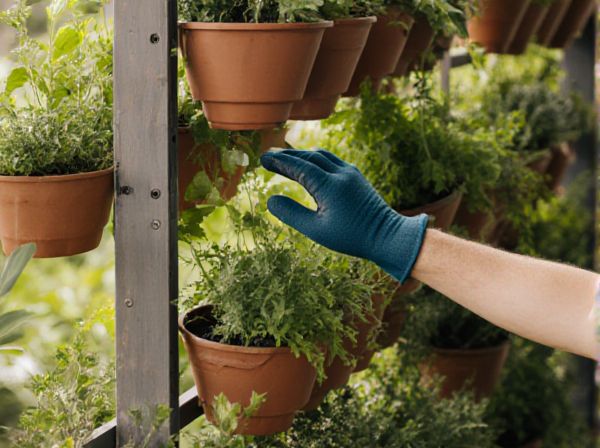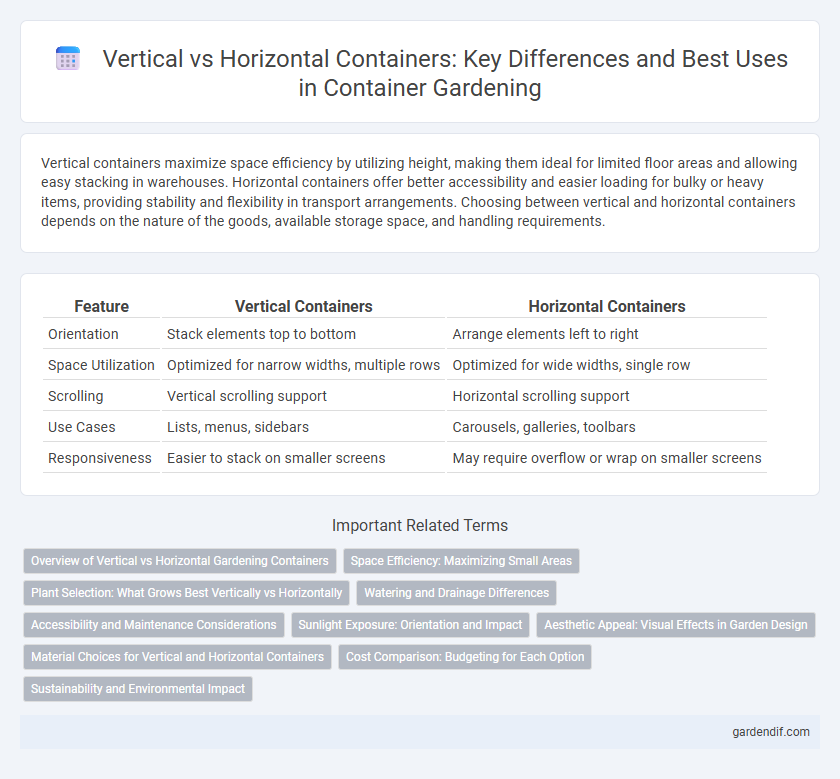
Vertical containers vs Horizontal containers Illustration
Vertical containers maximize space efficiency by utilizing height, making them ideal for limited floor areas and allowing easy stacking in warehouses. Horizontal containers offer better accessibility and easier loading for bulky or heavy items, providing stability and flexibility in transport arrangements. Choosing between vertical and horizontal containers depends on the nature of the goods, available storage space, and handling requirements.
Table of Comparison
| Feature | Vertical Containers | Horizontal Containers |
|---|---|---|
| Orientation | Stack elements top to bottom | Arrange elements left to right |
| Space Utilization | Optimized for narrow widths, multiple rows | Optimized for wide widths, single row |
| Scrolling | Vertical scrolling support | Horizontal scrolling support |
| Use Cases | Lists, menus, sidebars | Carousels, galleries, toolbars |
| Responsiveness | Easier to stack on smaller screens | May require overflow or wrap on smaller screens |
Overview of Vertical vs Horizontal Gardening Containers
Vertical gardening containers maximize space by allowing plants to grow upward, making them ideal for small areas and balconies. Horizontal containers provide ample surface area for root expansion, better suited for sprawling plants and crops requiring extensive soil. Choosing between vertical and horizontal containers depends on available space, plant type, and desired garden layout.
Space Efficiency: Maximizing Small Areas
Vertical containers utilize height more effectively, allowing for increased storage capacity in limited floor space, making them ideal for small areas. Horizontal containers spread out storage but consume more footprint, which can reduce overall efficiency in compact environments. Maximizing small spaces often involves choosing vertical containers to optimize volume without expanding the container's base.
Plant Selection: What Grows Best Vertically vs Horizontally
Vertical containers maximize space for climbing plants like tomatoes, cucumbers, and pole beans, which thrive on trellises or stakes due to their vining nature. Horizontal containers are ideal for sprawling plants such as lettuce, spinach, and strawberries, which require ample root spread and surface area for optimal growth. Selecting plants based on container orientation ensures better nutrient absorption, light exposure, and overall yield.
Watering and Drainage Differences
Vertical containers offer improved drainage due to gravity assisting water flow through multiple stacked layers, reducing waterlogging risk. Horizontal containers tend to retain more moisture, requiring careful watering to prevent root rot and ensuring even water distribution across the container's length. Proper drainage design in vertical setups enhances aeration and promotes healthier root systems compared to horizontal containers.
Accessibility and Maintenance Considerations
Vertical containers offer easier access for stacking and loading in confined spaces, facilitating efficient use of vertical storage without occupying much floor area. Horizontal containers provide simpler maintenance due to their stable base and broader access points, allowing technicians to service components without the need for specialized equipment. Choosing between vertical and horizontal containers depends on the specific accessibility requirements and maintenance protocols of the storage environment.
Sunlight Exposure: Orientation and Impact
Vertical containers maximize sunlight exposure by allowing plants to receive light from multiple angles, enhancing photosynthesis and growth. Horizontal containers, while easier to manage, often limit sunlight exposure to the upper surface, potentially causing uneven growth and reduced vigor. Strategic orientation of vertical containers toward sunlight sources optimizes light absorption, crucial for plant health in indoor or limited space gardening.
Aesthetic Appeal: Visual Effects in Garden Design
Vertical containers create striking visual interest by drawing the eye upward, adding height and depth to garden spaces while maximizing limited ground area. Horizontal containers emphasize width and layering, enabling the display of a diverse range of plants at eye level that fosters a lush and expansive garden aesthetic. Combining both container orientations enriches garden design by balancing structure and organic flow, enhancing overall aesthetic appeal.
Material Choices for Vertical and Horizontal Containers
Vertical containers commonly utilize materials such as stainless steel and high-density polyethylene (HDPE) for their strength and corrosion resistance, making them ideal for storage of liquids and chemicals. Horizontal containers often employ fiberglass-reinforced plastic (FRP) and aluminum, chosen for their lightweight properties and ease of transportation. Material selection for vertical and horizontal containers is driven by mechanical stress tolerance, environmental exposure, and specific application requirements.
Cost Comparison: Budgeting for Each Option
Vertical containers generally offer cost savings in terms of land usage and footprint efficiency, making them ideal for limited space environments. Horizontal containers require more extensive site preparation and larger land areas, often increasing initial investment costs. Budgeting for vertical options typically results in lower long-term costs due to economies of scale and reduced infrastructure expenses.
Sustainability and Environmental Impact
Vertical containers maximize space efficiency by stacking upwards, reducing land use and minimizing the carbon footprint associated with transportation and storage. Horizontal containers, while easier to access and maintain, often require more surface area, leading to increased land disturbance and higher environmental impact. Choosing vertical container systems supports sustainable practices by optimizing storage capacity and reducing resource consumption in logistics operations.
Vertical containers vs Horizontal containers Infographic

 gardendif.com
gardendif.com